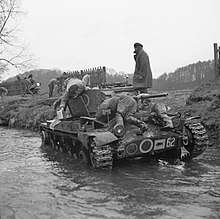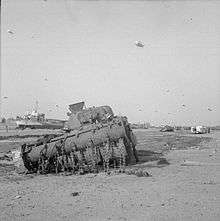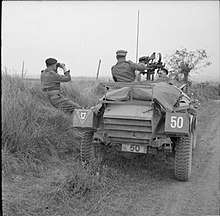30th Armoured Brigade
The 30th Armoured Brigade was a World War II British Army unit that served in the campaign in Western Europe as part of the 79th Armoured Division.[1]
| 30th Armoured Brigade | |
|---|---|
 Sherman Crab flail tanks of the Westminster Dragoons carry infantry of the 2nd Argyll and Sutherland Highlanders during the advance east of Beringe, 22 November 1944. | |
| Active | 1940–1945 |
| Disbanded | 31 August 1945 |
| Country | United Kingdom |
| Branch | British Army |
| Type | Armoured brigade |
| Role | Infantry support |
| Equipment | Sherman Crab |
| Engagements | Western Front (1944–1945) |
| Battle honours | The Rhineland (8 February – 10 March 1945) |
| Commanders | |
| Notable commanders | Brigadier Nigel W. Duncan (1943–1945) |
Unit history



The 30th Armoured Brigade was created on 27 December 1940[1][2] as part of Northern Command.[2] It was initially formed from the 2nd Battalion, The Queen's Westminsters, a motorized infantry unit, which was joined by a cavalry unit, the 23rd Hussars, three days later, on 30 December.[3] Just over a week later, on 8 January 1941, the 23rd Hussars were replaced by the 22nd Dragoons,[3] and on 28 January the brigade was transferred to Western Command.[2]
On 8 March the brigade was augmented with the addition of another cavalry unit, the 2nd County of London Yeomanry (Westminster Dragoons),[3] and the following day another armoured regiment, the 1st Lothians and Border Yeomanry was added,[3] and the brigade also became part of the 11th Armoured Division, alongside the 29th Brigade,[2] for training, under the command of Major-General Percy Hobart, and operating the Valentine tank. Soon after, on 22 March, the 2nd Queen's Westminsters were renamed the 12th Battalion, King's Royal Rifle Corps.[3]
On 20 April 1942 the brigade was briefly transferred to the 3rd Armoured Group, and on 13 May it was transferred again to the 42nd Armoured Division.[2] The brigade lost the 12th KRRC on 15 October 1943,[3] and two days later, on 17 October was transferred for the last time, joining the 79th Armoured Division,[2] and finding itself once again under the overall command of Percy Hobart.
It now consisted of three Armoured units - the 22nd Dragoons, 1st Lothian and Border Yeomanry, and the Westminster Dragoons - that would remain the backbone of the brigade. After a succession of officers, command was assumed by Brigadier Nigel W. Duncan on 6 December 1943.[4] Duncan would command the brigade during its active service from D-Day until after the end of the war in Europe.
By the time of the Normandy landings on 6 June 1944 all three units of the 30th Armoured Brigade were operating the Sherman Crab flail tank, designed to clear paths through minefields and other obstructions.[5] However in common with other 79th Division units they rarely found themselves operating together. On D-Day itself, 'A' Squadron of the 22nd Dragoons, and two troops of 'C' Squadron, landed on Sword Beach with the first wave, while the 22nd's 'B' Squadron landed on Juno Beach, with the remainder of 'C' Squadron, landing there later in the day. The Westminster Dragoons 'B' and 'C' Squadrons landed alongside the 50th Infantry Division on 'Jig' and 'King' sectors of Gold Beach in the first wave,[6] with 'A' Squadron landing later in the day on 'Queen' sector of Sword Beach.[7] The 1st Lothian and Border Yeomanry did not arrive in France until 12 July, but soon found itself in action around Caen.[8]
30th Brigade continued in action for the rest of the war, taking part in several operations, including the assault on Le Havre in September 1944,[9] the invasion of Walcheren ("Operation Infatuate II") in November 1944,[8] and the crossing of the Rhine in March 1945.[9]
It also had various additional units attached to it temporarily. The 141st Regiment Royal Armoured Corps was part of the brigade from July to September 1944,[3] and the 11th Royal Tank Regiment was added from December 1944 to January 1945.[3] 11th RTR returned with 4th Royal Tank Regiment at the end of March 1945 until the end of April.[3]
Finally, the 22nd Dragoons, the 1st Lothians and Border Yeomanry and the Westminster Dragoons were all transferred from the brigade on 31 August 1945, bringing its existence to an end.[3]
Order of Battle
| Unit | From | To |
|---|---|---|
| 2nd Battalion, The Queen's Westminsters (renamed 12th Battalion, King's Royal Rifle Corps on 22 March 1941) | 27 December 1940 | 15 October 1943 |
| 23rd Hussars | 30 December 1940 | 8 January 1941 |
| 22nd Dragoons | 8 January 1941 | 31 August 1945 |
| 2nd County of London Yeomanry (Westminster Dragoons) | 8 March 1941 | 31 August 1945 |
| 1st Lothians and Border Yeomanry | 9 March 1941 | 31 August 1945 |
| 141st Regiment Royal Armoured Corps (formerly 7th Battalion, The Buffs) | 2 July 1944 | 4 September 1944 |
| 11th Royal Tank Regiment | 22 December 1944 | 27 January 1945 |
| 4th Royal Tank Regiment | 30 March 1945 | 25 April 1945 |
| 11th Royal Tank Regiment | 31 March 1945 | 25 April 1945 |
Commanders
| Name | From | To | Notes |
|---|---|---|---|
| Brigadier J. H. Anstice | 31 December 1940 | 14 April 1941 | Later CO 7th & 8th Armoured Brigades |
| Lieutenant-Colonel J. G. Crabbe | 14 April 1941 | 13 May 1941 | |
| Brigadier Sir C. F. Keightley | 13 May 1941 | 24 December 1941 | Later CO 11th and 6th Armoured Divs., 78th Div., and V Corps. |
| Brigadier J. J. Kingstone | 24 December 1941 | 4 March 1942 | |
| Brigadier O. L. Prior-Palmer | 4 March 1942 | 26 August 1942 | Later CO 29th & 7th Armoured Brigades. MP for Worthing 1945–1964. |
| Brigadier J. A. Aizlewood | 24 August 1942 | 3 December 1942 | Later CO 42nd Armoured Div. |
| Lieutenant-Colonel J. G. Crabbe | 3 December 1942 | 13 January 1943 | |
| Lieutenant-Colonel G. L. Craig | 13 January 1943 | 16 January 1943 | |
| Brigadier P. G. S. Gregson-Ellis | 16 January 1943 | 20 July 1943 | Later CO 1st (Guards) Bde. & 5th Div. |
| Brigadier G. P. B. Roberts | 20 July 1943 | 6 December 1943 | Later CO 11th & 7th Armoured Divs. |
| Brigadier N. W. Duncan | 6 December 1943 | 20 May 1945 | Later Director, Royal Armoured Corps Centre, & Curator, The Tank Museum.[9] |
| Lieutenant-Colonel C. J. Y. Dallmeyer | 20 May 1945 | 8 July 1945 | CO, 1st Lothians and Border Yeomanry.[10] |
| Brigadier N. W. Duncan | 8 July 1945 | 31 August 1945 | |
References
- "Organization of British Armoured Brigades 1939–1945" (PDF). Combined Arms Research Library. U.S. Army. Archived from the original (PDF) on 28 January 2017. Retrieved 10 December 2018.
- "30 Armoured Brigade: Unit Superiors". Orders of Battle Military Unit Database. Archived from the original on 14 December 2018. Retrieved 9 August 2018.
- "30 Armoured Brigade: Order of Battle". Orders of Battle Military Unit Database. Archived from the original on 22 March 2016. Retrieved 9 August 2018.
- "30 Armoured Brigade: Command Appointments". Orders of Battle Military Unit Database. Archived from the original on 14 December 2018. Retrieved 10 December 2018.
- "M4A4 Sherman V Flail". The Tank Museum, Bovington. Archived from the original on 28 July 2011. Retrieved 10 December 2018.
- "The Westminster Dragoons - 2nd County of London Yeomanry". The Tank Museum. Archived from the original on 23 September 2015. Retrieved 10 December 2018.
- Ramsey, Jim (3 June 2004). "D-Day Memories of a Tank Gunner: With 'A' Squadron Westminster Dragoons". BBC History. Retrieved 10 December 2018.
- "Tpr. James Douglas Scott: 1st Lothian & Border Horse". Wartime Memories Project. Retrieved 10 December 2018.
- "Nigel W. Duncan". The Tank Museum. Retrieved 10 December 2018.
- "Allied Forces: Infatuate II (Westkapelle)" (PDF). Zeeland 1940–1945 (in Dutch). Retrieved 10 December 2018.
External links
- "30 Armoured Brigade". Orders of Battle.com.